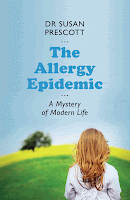Avoidance is always the first rule of allergy control but since pollens can be carried vast distances in the strong spring winds, spreading across suburbs, pollen immunotherapy is the best option for those with significant hayfever symptoms, according to leading WA paediatric allergist and immunologist Susan Prescott.
Immunotherapy, which aimed to induce a lasting immune tolerance through gradually giving increasing doses of the allergen over an extended period, starting at extremely low levels, was the only potential curative treatment for allergic disease, she said.
There was now strong evidence that it could not only be effective in the treatment of both allergic rhinitis (hayfever) and allergic rhinoconjunctivitis (eye and nose allergy) but also help control asthma and eczema in the same patient. Preliminary evidence also indicated it might even reduce disease progression from hayfever to asthma and reduce the development of new sensitisations.
She said that in the past a lack of awareness in both the medical profession and the public about the availability of this treatment option had seen suitable patients "falling through the cracks" and not being assessed and referred. It was traditionally given by injection and had been in use for more than 100 years, well before the allergy process was understood.
However, immunotherapy now attracted more attention, she said. This included sublingual immunotherapy, allowing the treatment to be given by tablets or drops placed under the tongue. This had grown in popularity in WA over the past few years since its introduction but was still more expensive and often not readily available through the public hospital system.
"Unlike other medications, immunotherapy targets and suppresses the underlying Type 2 allergic immune response," the professor said.
"By addressing the immune problem that causes allergies, it is the only treatment that can alter the natural history of disease."
Immunotherapy is considered a good treatment option in hayfever patients who have moderate, severe or persistent disease and still have symptoms after trying symptomatic treatments, such as antihistamines and nose sprays.
However, patients who suffer from severe, unstable asthma should not consider it.
Available for most common inhaled allergens and with proven benefits in patients sensitised to grass and tree pollens, house dust mites, moulds and some animal dander, the best candidates are those who are sensitised to only a few allergens.
Immunotherapy began, Professor Prescott said, with an up-dosing schedule followed by a maintenance period of three to five years.
"Although patients can be quite quickly 'desensitised', this may not be lasting unless there is continued long-term exposure," she said.
"A more permanent tolerance is driven by changes in underlying cellular immune function, with induction of regulatory T cells and suppression of the Type 2 allergic T cell response."
Studies on immunotherapy side-effects show moderate reactions such as rhinitis, mild asthma or hives are estimated to occur in one in 1500 injections. More severe reactions are rare, with anaphylaxis occurring about once per million injections.
In comparison, oral immunotherapy for food allergy, Professor Prescott said, was still considered "very dangerous" and experimental because of the significant safety concerns.
But there was hope that standardised protocols could eventually be determined and set for clinical practice.
THE TREATMENT
Antihistamine tablets. Providing relief for mild and intermittent symptoms, these tablets are widely available without a prescription and block histamine receptors to reduce symptoms. New generation “non-sedating” antihistamines are preferable to older preparations which can cause drowsiness and significantly impair performance, learning and concentration.
Nasal steroid sprays. Those with more persistent, moderate or severe symptoms are usually prescribed nasal steroid sprays effective at suppressing nasal inflammation. The sprays are not designed to provide “instant relief” and need to be used regularly over a period of time to achieve the best anti-inflammatory result. It may take a month to see an improvement. Considered safe for adults and children and not having an impact on growth, they can be used long term without damage to the lining of the nose. Some people experience local irritation and dryness but this can be reduced by saline drops. Newer-generation nasal steroids have also been designed so their absorption is minimal when swallowed with nasal secretions.
Eye drops. Antihistamine eye drops are effective for controlling eye symptoms. New “anti-leukotriene” tablets used in asthma may also have some benefit and work by blocking the action of leukotriene inflammatory products.
Decongestants. Do not play a role in the long-term management of hayfever. These nasal sprays, tablets and syrups are mainly for short-term( use for viral infections and upper respiratory tract infections. They may( cause chronic damage to the lining membranes of the nose if used for long periods of time. Often hayfever patients suffer “rebound congestion” when stopping these medications and this can be worse than their hayfever symptoms.
Source: The Allergy Epidemic — A Mystery of Modern Life by Professor Susan Prescott



















